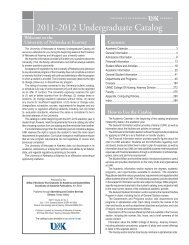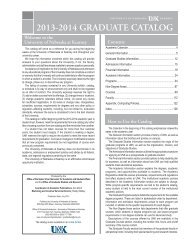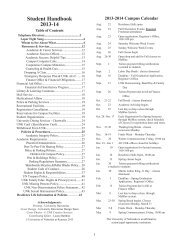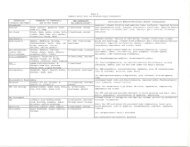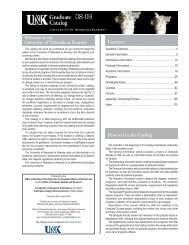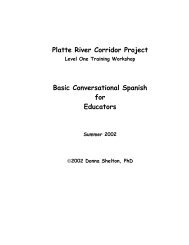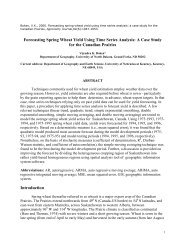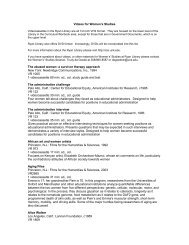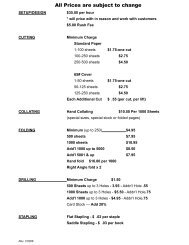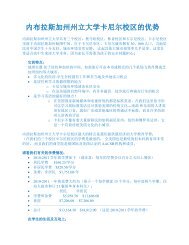ACSM Fit Society® Page - American College of Sports Medicine
ACSM Fit Society® Page - American College of Sports Medicine
ACSM Fit Society® Page - American College of Sports Medicine
Create successful ePaper yourself
Turn your PDF publications into a flip-book with our unique Google optimized e-Paper software.
Spring 2011<br />
A m e r i c A n c o l l e g e o f S p o r t S m e d i c i n e<br />
AcSm <strong>Fit</strong> pAge<br />
<strong>Society®</strong><br />
Supported by<br />
Letter from the Editor<br />
by Dixie L. Thompson, Ph.D., F<strong>ACSM</strong><br />
Welcome to the spring 2011 edition <strong>of</strong> the<br />
<strong>ACSM</strong> <strong>Fit</strong> Society ® <strong>Page</strong>, sponsored by<br />
Liberty Mutual. Physical activity and<br />
nutrition are both critical components <strong>of</strong> the<br />
energy balance equation, and this issue is<br />
dedicated entirely to nutrition. This issue<br />
will help you clear up common nutrition<br />
myths, find simple ways to eat healthy on a<br />
budget, derive essential nutrients from a<br />
vegetarian or vegan diet, keep yourself fueled<br />
during endurance exercise and select the<br />
appropriate dietary supplements for your<br />
unique needs. We hope these articles equip<br />
you with the knowledge you need to make<br />
smart choices about what you eat.<br />
Please look over this information that <strong>ACSM</strong><br />
experts have prepared for you, share it with<br />
friends and family, and enjoy the fitness<br />
opportunities afforded by good nutrition.<br />
Dixie L. Thompson, Ph.D., F<strong>ACSM</strong><br />
Editor, <strong>ACSM</strong> <strong>Fit</strong> Society ® <strong>Page</strong><br />
Email: dixielee@utk.edu<br />
To subscribe to the <strong>ACSM</strong> <strong>Fit</strong> Society ® <strong>Page</strong>,<br />
please send an email to publicinfo@acsm.org.<br />
THEME: NUTRITION<br />
Clearing Up<br />
Common<br />
Nutrition<br />
Myths<br />
by Janet Walberg Rankin, Ph.D., F<strong>ACSM</strong><br />
Who hasn’t been confused by conflicting<br />
reports about what to eat? Let’s take a look at<br />
recent scientific evidence to clear up five very<br />
common nutrition myths.<br />
Myth 1: Calcium will<br />
guarantee strong bones.<br />
Most adults should consume between 1000-<br />
1300 mg <strong>of</strong> calcium per day in order to<br />
promote good health, including bone health.<br />
However, even this level <strong>of</strong> calcium intake<br />
should not be considered an insurance policy<br />
against bone loss. Exercise, hormones and<br />
vitamin D are major contributors to bone<br />
health. Some believe that most people don’t<br />
need to worry about vitamin D because our<br />
skin naturally produces it after sun exposure.<br />
However, recent research broke this myth wide<br />
open.<br />
Growing evidence <strong>of</strong> the importance <strong>of</strong><br />
vitamin D led some scientists to propose that<br />
we triple the previously recommended 400 IU<br />
(international unit) daily amount <strong>of</strong> vitamin D.<br />
Experts at the Institute <strong>of</strong> <strong>Medicine</strong> (IOM)<br />
recently took on this volatile topic to develop a<br />
consensus. In Dec. 2010, the IOM report on<br />
vitamin D and calcium bumped the<br />
recommended vitamin D intake to 600 IU per<br />
day for children and adults and up to 800 IU<br />
per day for those over 71 years. Oversupplementing,<br />
defined as an intake greater<br />
than 4000 IU, can damage kidneys and<br />
contribute to kidney stones, so experts caution<br />
against consuming too much calcium.<br />
Myth 2: Low-carb diets are<br />
the best for weight loss.<br />
Several large-scale studies have compared<br />
popular weight loss diets head-to-head, and<br />
none <strong>of</strong> the diets emerged as the clear winner.<br />
This may be partly due to the fact that<br />
although people adhere carefully to the<br />
restrictions initially, they digress toward old<br />
eating habits over time. The boring conclusion<br />
is that the people who adhere most closely to<br />
the diet recommendations are most successful<br />
in their weight loss, regardless <strong>of</strong> which diet<br />
they follow.<br />
When health factors other than weight loss are<br />
measured, most studies report the greatest<br />
reduction in blood triglycerides for low-carb<br />
diets and the greatest reduction in blood<br />
cholesterol levels for low-fat diets. Although<br />
my pr<strong>of</strong>essional opinion holds to a low-fat diet<br />
rich in fruits, vegetables and whole grains as<br />
the best for weight loss, I would consider<br />
agreeing to a low-carb diet for someone who<br />
prefers this, as long as they agree to careful<br />
monitoring <strong>of</strong> their micronutrient intake and<br />
blood cholesterol levels.<br />
Myth 3: Water is just as<br />
good as a sports drink for<br />
athletes.<br />
This myth needs clarification. Although water<br />
is a good hydrator for most people under most<br />
➤<br />
I N S I D E T H I S I S S U E :<br />
1 | Letter from the Editor<br />
1 | Clearing Up Common Nutrition Myths<br />
2 | Q&A with <strong>ACSM</strong><br />
3 | Top 10 Simple Ways to Eat Healthy on a Budget<br />
4 | Deriving Essential Nutrients from Vegetarian and<br />
Vegan Diets<br />
5 | Preventing the “Low-Fuel Light” in Endurance Exercise<br />
5 | Dietary Supplements for Aging: A Fountain <strong>of</strong> Youth or<br />
Deluge <strong>of</strong> Dollars?<br />
7 | The Athlete’s Kitchen
Nutrition Myths (continued from page 1)<br />
conditions, athletes are anything but typical.<br />
Highly competitive athletes may experience<br />
significant reduction <strong>of</strong> glycogen stores and<br />
dehydration during an intense, prolonged<br />
competition or workout. <strong>Sports</strong> drinks<br />
provide carbohydrate as well as the<br />
electrolytes and fluid that replenish critical<br />
energy reserves and delay fatigue. I believe if<br />
exercise is less than an hour, or <strong>of</strong> only<br />
moderate intensity, water is sufficient. Highintensity,<br />
longer performance may be<br />
improved by regular consumption <strong>of</strong> a sports<br />
drink.<br />
Myth 4: I eat only 1,200<br />
calories per day, but I can’t<br />
lose weight.<br />
Few people are good at estimating portion<br />
sizes <strong>of</strong> their food. This can cause them to<br />
underestimate their true calorie intake. For<br />
example, a USDA study found that the<br />
average baked potato is 2.5 times the defined<br />
serving size. So, using the food table calories<br />
for one potato may substantially<br />
underestimate actual intake. Alternatively,<br />
maybe you only ate 1,200 calories one day,<br />
but you splurged the next with 2,500 calories.<br />
It is difficult to accurately determine how<br />
many calories you should consume each day<br />
to lose weight (it’s best to consult a dietitian),<br />
but you can get a rough estimate <strong>of</strong> your daily<br />
goal by multiplying your weight in kilograms<br />
by 35 and subtracting 500-600 calories.<br />
Myth 5: Avoid c<strong>of</strong>fee.<br />
This is my personal favorite myth, as I am<br />
rarely seen first thing in the morning without<br />
my c<strong>of</strong>fee. Recent research does not vilify<br />
c<strong>of</strong>fee; rather, it finds health benefits in<br />
consuming this brew. C<strong>of</strong>fee consumption has<br />
been associated in some research studies with<br />
lower risk <strong>of</strong> diabetes, stroke and Parkinson’s<br />
disease. In fact, one recent study <strong>of</strong> more than<br />
86,000 nurses reported that the risk <strong>of</strong> dying<br />
was 26 percent lower among those who drank<br />
four to five cups <strong>of</strong> c<strong>of</strong>fee per day compared<br />
to those who abstained. People with heart or<br />
sleep problems, or women who are pregnant,<br />
should consult their doctor first, but most <strong>of</strong><br />
us can drink our morning c<strong>of</strong>fee without<br />
worry.<br />
So, why do we get conflicting messages about<br />
nutrition? Scientists are a naturally skeptical<br />
bunch who continually question “truths” to be<br />
sure they are correct. One must look for the<br />
consensus out <strong>of</strong> the many research studies.<br />
Since most <strong>of</strong> us can’t put the time into<br />
reading all that research, one <strong>of</strong> the best ways<br />
is to use good online sources like<br />
Nutrition.gov or the USDA National<br />
Agriculture Library. You can also talk to a<br />
dietitian. Either way, rely on the experts to sift<br />
through the latest claims and scientific<br />
discoveries to steer you down the right path.<br />
<strong>ACSM</strong><br />
A M E R I C A N C<br />
FIT<br />
O L L E G E O F S P O R T S M E D I C I N E<br />
SOCIETY® PAGE<br />
<strong>ACSM</strong> <strong>Fit</strong> Society ® <strong>Page</strong> Editorial Board:<br />
Dixie L. Thompson, Ph.D., F<strong>ACSM</strong>, Editor<br />
University <strong>of</strong> Tennessee<br />
Thomas S. Altena, Ed.D.<br />
Southwest Missouri State University<br />
Katherine A. Beals, Ph.D., R.D., F<strong>ACSM</strong><br />
University <strong>of</strong> Utah<br />
Dawn Coe, Ph.D.<br />
University <strong>of</strong> Tennessee<br />
Jessica Ellis, M.D.<br />
Orthopaedic and Rheumatology Associates<br />
Kate A. Heelan, Ph.D., F<strong>ACSM</strong><br />
University <strong>of</strong> Nebraska-Kearney<br />
Cherilyn Hultquist, Ph.D.<br />
Kennesaw State University<br />
Gerald Jerome, Ph.D.<br />
Towson University<br />
Anthony C. Luke, M.D., M.P.H., F<strong>ACSM</strong><br />
University <strong>of</strong> California, San Francisco<br />
Lynn Millar, Ph.D., F<strong>ACSM</strong><br />
Andrews University<br />
<strong>ACSM</strong> is the world’s largest association devoted to<br />
sports medicine and exercise science. <strong>ACSM</strong> advances and<br />
integrates scientific research to provide educational and<br />
practical applications <strong>of</strong> exercise science and sports<br />
medicine.<br />
Permission to reprint material from this publication is<br />
granted by <strong>ACSM</strong> contingent upon manuscripts being<br />
reprinted in total without alteration and on proper credit<br />
given to <strong>ACSM</strong> by citing <strong>ACSM</strong> <strong>Fit</strong> Society ® <strong>Page</strong>, issue and<br />
page number; e.g., “Reprinted with permission <strong>of</strong> the<br />
<strong>American</strong> <strong>College</strong> <strong>of</strong> <strong>Sports</strong> <strong>Medicine</strong>, <strong>ACSM</strong> <strong>Fit</strong> Society ®<br />
<strong>Page</strong>, Spring 2011, p. 3.”<br />
Q&A<br />
by Anthony Luke, M.D., F<strong>ACSM</strong><br />
Q: I’ve heard <strong>of</strong> athletes drinking chocolate milk for recovery. Is this for real?<br />
A: Chocolate milk has been shown to be effective as a recovery beverage following a period <strong>of</strong><br />
increased training. During long bouts <strong>of</strong> exercise, an athlete’s energy stores (known as glycogen) can<br />
get depleted. Chocolate milk is rich in high-quality protein and carbohydrates. Drinking a beverage<br />
like chocolate milk, which has more carbohydrates and proteins than water or some sports drinks,<br />
may improve recovery because it increases muscle glycogen storage as well as replenishes fluids.<br />
In a recent study <strong>of</strong> cyclists riding twice with a recovery period <strong>of</strong> two hours between rides, athletes<br />
who drank chocolate milk performed better than those who did not. Similarly, a recent study <strong>of</strong><br />
soccer players showed lower markers <strong>of</strong> muscle damage (creatine kinase) in athletes who drank<br />
chocolate milk as opposed to a recovery beverage with similar calories. Milk also has the benefits <strong>of</strong><br />
calcium, potassium and magnesium, which can be helpful for athletes. Low-fat chocolate milk can<br />
be a good recovery drink for athletes.<br />
Q: I’m a female runner in my 30s, and I run regularly. What do I need to consider for<br />
vitamin and mineral supplements? Do I really need them?<br />
A: Athletes are commonly low in vitamins and minerals such as calcium, vitamin D, the B vitamins,<br />
iron, zinc, magnesium and some antioxidants, such as vitamins C, E, A-carotene and selenium.<br />
Calcium, vitamin D and iron are particularly important for women. <strong>ACSM</strong>’s updated Position Stand<br />
on Nutrition and Athletic Performance recommends that, “Vitamin and mineral supplements are not<br />
felt to be needed if an athlete has adequate dietary intake from a variety <strong>of</strong> foods to supply energy<br />
and maintain body weight. However, athletes who are at risk for nutritional issues, including those<br />
who restrict energy intake, use severe weight-loss practices, eliminate one or more food groups from<br />
their diet, or consume unbalanced diets with low micronutrient density, may require supplements.”<br />
In the end, a healthy diet is still the best solution for making sure your body gets the nutrients it<br />
needs.<br />
Q: Is kale a new superfood?<br />
A: Kale is a leafy green vegetable in the cabbage, broccoli and cauliflower family. There are nutrients<br />
in kale that have powerful antioxidant and possible anti-inflammatory properties. Kale has<br />
sulforaphane, which is thought to have potent anti-cancer effects. Kale is also rich in beta-carotene,<br />
vitamin K, vitamin C, lutein and zeaxanthin, and it contains some calcium. More than 45 flavonoids<br />
(continued on page 8)<br />
➤<br />
<strong>ACSM</strong> <strong>Fit</strong> Society ® <strong>Page</strong> • A Quarterly Publication <strong>of</strong> the <strong>American</strong> <strong>College</strong> <strong>of</strong> <strong>Sports</strong> <strong>Medicine</strong> • www.acsm.org • Spring 2011 <strong>Page</strong> 2
THEME: NUTRITION<br />
Top 10<br />
Simple Ways<br />
to Eat Healthy<br />
on a Budget<br />
by Stacy Mitchell, R.D., L.D.<br />
Healthy and inexpensive? Many people don’t<br />
think these words belong in the same<br />
sentence. Simple, smart planning with your<br />
food can make it happen every week.<br />
Prioritize the foods in your diet, and go for<br />
nutrient-dense foods first, such as fruits,<br />
vegetables, whole grains, lean protein and<br />
low-fat dairy. Cut the junk out <strong>of</strong> the grocery<br />
cart, as you get the biggest bang for your buck<br />
with healthier foods.<br />
Eating healthy won’t cost a fortune if you<br />
follow these ten simple tips:<br />
1. Shop the weekly ad.<br />
Shopping the sale advertisement from your<br />
local grocery store is the first step to stretching<br />
the food dollar the healthy way. Take some<br />
time to plan weekly meals using healthier ad<br />
items.<br />
2. Embrace seasonal fresh<br />
produce.<br />
Fresh fruits and vegetables in season are not<br />
only a great buy in the weekly ad but they are<br />
also at their peak flavor. Pick a new fruit or<br />
vegetable each week to add some variety.<br />
3. Plan a meatless Monday.<br />
The largest food dollar in the meal comes from<br />
the protein source. Substituting a lower-cost<br />
protein can save $10 to $20 per week. Try<br />
beans, eggs, nut butters or even cheese in your<br />
Monday meal.<br />
4. Stretch your meat with<br />
beans.<br />
Another way to save some money in the<br />
protein department is to substitute a can <strong>of</strong><br />
beans, or two cups <strong>of</strong> dried beans, for every<br />
half pound <strong>of</strong> ground meat. For example, add<br />
one can <strong>of</strong> mashed black beans to a half<br />
pound <strong>of</strong> ground beef. Add taco seasoning<br />
and sauce to the dish, and your family will<br />
never know your little secret!<br />
5. Go for store brands.<br />
Private labels can save you an average <strong>of</strong> 15-<br />
25 percent over the national name brand.<br />
Find some especially great savings in the grain<br />
group with private labels—go for 100 percent<br />
whole wheat or whole grain for best nutrition.<br />
6. Find fruits and veggies at<br />
the salad bar.<br />
The goal is always adding more fruits and<br />
vegetables to daily meals, but it can be difficult<br />
to keep produce fresh if you are buying for<br />
just one or two people. To avoid wasting food,<br />
take a look at the salad bar and buy per<br />
pound. Pick up your favorite veggies, and<br />
purchase only what you will actually eat.<br />
Some stores even have some pre-packaged<br />
veggies in snack-size bags for less than one<br />
dollar! These are perfect for a lunch bag or<br />
snack.<br />
7. Don’t forget frozen<br />
veggies.<br />
Frozen vegetables are a staple to any meal.<br />
From broccoli to spinach, frozen veggies are<br />
loaded with antioxidants and essential<br />
nutrients, and they can be added to your<br />
favorite pasta dish or soup in a snap. Look for<br />
private labels for only a few dollars per large<br />
bag.<br />
8. Get back to basics.<br />
Skip the packaged meal kits, and make your<br />
meal from scratch! Don’t worry—it can still be<br />
simple to put a meal together. Instead <strong>of</strong><br />
buying a box <strong>of</strong> Hamburger Helper, purchase<br />
whole grain noodles, sauce and a can <strong>of</strong> fireroasted,<br />
low-sodium diced tomatoes. You’ll<br />
save up to a dollar per serving and up to 500<br />
milligrams <strong>of</strong> sodium. Packaged items are<br />
loaded with sodium—watch out!<br />
9. Reduce fat in ground<br />
beef.<br />
Eighty-five percent lean ground beef can still<br />
be a part <strong>of</strong> the grocery list, but make sure<br />
you drain excess fat from the beef crumbles<br />
for a healthier option. One study by the<br />
<strong>American</strong> Dietetic Association found that<br />
simply rinsing cooked beef crumbles with hot<br />
water and patting excess fat with a paper<br />
towel can reduce the fat content <strong>of</strong> cooked<br />
ground beef by as much as 50 percent! (If you<br />
have to follow a low-fat diet, 90 percent lean<br />
beef is still recommended.)<br />
10. Eat more meals from<br />
home.<br />
Something as simple as eating at home can<br />
really add up to big savings. Plus, you can<br />
cook once and serve twice by using leftover<br />
ingredients for lunch the next day.<br />
Don’t let your budget be a barrier to eating<br />
healthy. These ten simple steps are just a few<br />
ways that you can eat healthy on a budget.<br />
<strong>ACSM</strong> <strong>Fit</strong> Society ® <strong>Page</strong> • A Quarterly Publication <strong>of</strong> the <strong>American</strong> <strong>College</strong> <strong>of</strong> <strong>Sports</strong> <strong>Medicine</strong> • www.acsm.org • Spring 2011 <strong>Page</strong> 3
THEME: NUTRITION<br />
Deriving<br />
Essential<br />
Nutrients<br />
from<br />
Vegetarian<br />
and Vegan<br />
Diets<br />
by Pamela S. Hinton, Ph.D.<br />
A vegetarian is someone who does not eat<br />
meat, poultry or fish, although self-described<br />
vegetarians come in many forms. Some eat<br />
fish, but not meat or poultry (semivegetarians).<br />
Some eat dairy products and eggs<br />
(lacto-ovo vegetarians). Some eat only plantbased<br />
foods (vegans).<br />
There are many reasons people adopt a plantbased<br />
diet, such as economic reasons, religious<br />
beliefs or concerns for personal health, the<br />
environment or animal welfare. Regardless <strong>of</strong><br />
the motivation for choosing this diet,<br />
vegetarians can be healthier than their<br />
omnivorous counterparts. However, by not<br />
eating animal foods, vegetarians eliminate<br />
prime sources <strong>of</strong> protein, n-3 fats DHA and<br />
EPA, iron, zinc, calcium and vitamins D and<br />
B12 from their diets. These potential deficits<br />
can be overcome with some careful planning<br />
and wise food choices.<br />
Dietary protein is broken down into its<br />
essential elements, amino acids, which the<br />
body uses as building blocks to make new<br />
proteins. Animal-based proteins contain the<br />
essential amino acids needed for protein<br />
synthesis, and they are considered “complete”<br />
or “high-quality” proteins. Although legumes,<br />
grains, nuts and seeds contain protein, they do<br />
not provide the ideal mix <strong>of</strong> amino acids that<br />
the body needs, so they are said to be<br />
“incomplete.” In addition, plant sources <strong>of</strong><br />
protein tend to be harder for the body to<br />
digest, so less <strong>of</strong> what we eat is available for<br />
use. However, eating the right combination <strong>of</strong><br />
plant proteins can give a vegetarian the<br />
needed mix <strong>of</strong> amino acids. Plant proteins that<br />
provide the required amino acids when<br />
combined complement each other to make a<br />
complete protein source. For example, whole<br />
wheat bread and peanut butter or beans and<br />
corn are complementary proteins.<br />
Complementary proteins should be consumed<br />
within the same day, but they do not have to<br />
be eaten simultaneously.<br />
Vegetarians who do not regularly eat fatty<br />
fish—such as salmon, tuna or cod—may be<br />
short on the essential n-3 (also called “omega-<br />
3”) fats DHA and EPA, which are important<br />
for cardiovascular, emotional and cognitive<br />
health. The n-3 fat found in plant sources—<br />
such as flax seed, walnuts, canola oil and<br />
soy—is α-linolenic acid (ALA). Unfortunately,<br />
the body converts only a small percentage <strong>of</strong><br />
ALA into DHA and EPA, so vegans should<br />
increase their intake <strong>of</strong> ALA-containing foods.<br />
While the most common DHA/EPA<br />
supplements are derived from fish oil, there<br />
are microalgae-produced supplements<br />
available for vegetarians who want extra<br />
assurance they are meeting their DHA/EPA<br />
requirements.<br />
The minerals iron and zinc—which are<br />
needed for oxygen transport, energy<br />
production, immunity, brain and nervous<br />
system health and muscle function—are likely<br />
to be lacking in a plant-based diet. There are<br />
compounds in plants that tie up iron and zinc<br />
so only a small fraction can be absorbed. The<br />
reduced bioavailability <strong>of</strong> iron is so significant<br />
that vegetarians need nearly twice as much<br />
iron each day as omnivores. Food-preparation<br />
techniques, such as soaking and sprouting<br />
beans and grains and leavening bread, allows<br />
more <strong>of</strong> the zinc and iron in these foods to be<br />
absorbed. Other strategies to increase the<br />
amount <strong>of</strong> iron and zinc absorbed are to<br />
consume them with a source <strong>of</strong> vitamin C and<br />
to avoid drinking c<strong>of</strong>fee or tea, which<br />
naturally contain compounds that reduce<br />
mineral absorption, at meals. It is preferable to<br />
use wise food selection to meet zinc and iron<br />
requirements, rather than take dietary<br />
supplements, because ingestion <strong>of</strong> large doses<br />
<strong>of</strong> a nutrient at one time can interfere with the<br />
absorption <strong>of</strong> other nutrients.<br />
Vegans, who do not consume milk and dairy<br />
products, are missing important sources <strong>of</strong><br />
dietary calcium and vitamin D. Although these<br />
are especially important during childhood and<br />
adolescence when the skeleton is growing,<br />
calcium and vitamin D are also essential for<br />
skeletal health in adults, and low intakes <strong>of</strong><br />
these nutrients might explain why vegans have<br />
a higher risk <strong>of</strong> bone fracture. Although there<br />
are plant-based foods that provide calcium,<br />
some <strong>of</strong> these (e.g., spinach) also contain<br />
compounds that tightly bind calcium,<br />
preventing it from being absorbed. Good<br />
sources <strong>of</strong> usable calcium include broccoli,<br />
kale, t<strong>of</strong>u and calcium-fortified products, such<br />
as soy and rice milk or fruit juice. Products<br />
that are fortified with calcium also are typically<br />
fortified with vitamin D, but check the label<br />
just to be sure. Foods are supplemented with<br />
either vitamin D3 or D2. Although vitamin D3<br />
is animal-derived, vegans can opt for products<br />
or supplements containing vitamin D2, which<br />
is made from yeast.<br />
Vegans need to either regularly consume foods<br />
fortified with vitamin B12 or take a<br />
supplement, as active vitamin B12 is present<br />
only in animal-based foods, such as dairy and<br />
eggs. The typical vegetarian diet contains<br />
enough folate to hide the early signs <strong>of</strong> a<br />
vitamin B12 deficiency, so the condition might<br />
go undetected until symptoms <strong>of</strong> nerve<br />
problems emerge.<br />
By following the suggestions above,<br />
vegetarians and vegans can derive the health<br />
benefits <strong>of</strong> a plant-based diet and meet<br />
requirements for these key nutrients, which<br />
are needed not only for optimal health but to<br />
maximize the positive effects <strong>of</strong> exercise.<br />
Vegetarians can get enough <strong>of</strong> the right amino<br />
acids in the right combinations to build<br />
muscle mass and strength with weight<br />
training. Likewise, a well-planned, plant-based<br />
diet can provide the iron needed to improve<br />
fitness with regular aerobic exercise and the<br />
calcium and vitamin D needed to increase<br />
bone mass following weight-bearing activity.<br />
Regardless <strong>of</strong> a person’s dietary preferences, it<br />
is critical to consume a diet with essential<br />
nutrients in order to maximize health.<br />
<strong>ACSM</strong> <strong>Fit</strong> Society ® <strong>Page</strong> • A Quarterly Publication <strong>of</strong> the <strong>American</strong> <strong>College</strong> <strong>of</strong> <strong>Sports</strong> <strong>Medicine</strong> • www.acsm.org • Spring 2011 <strong>Page</strong> 4
THEME: NUTRITION<br />
Preventing<br />
the “Low-Fuel<br />
Light” in<br />
Endurance<br />
Exercise<br />
Andrea Hacker Thompson M.S., R.D.<br />
Endurance athletes spend months training for<br />
a marathon or triathlon with a performance<br />
goal in mind. Often, nutrition is mistakenly<br />
left out <strong>of</strong> their plan. Nutrition should be a<br />
fundamental tool in every endurance athlete’s<br />
toolbox. During the training season, athletes<br />
should practice and sharpen their nutrition<br />
plan so they feel confident in it on race day.<br />
<strong>ACSM</strong> defines an endurance athlete as one<br />
who trains and competes for 90 minutes or<br />
longer. A nutritional plan is especially<br />
important for endurance athletes because they<br />
are at high risk <strong>of</strong> bonking, or as I call it,<br />
having the “low-fuel light” come on.<br />
The body <strong>of</strong> an endurance athlete is like a race<br />
car with two fuel tanks. The duration and<br />
intensity <strong>of</strong> the activity determines which tank<br />
is the primary fuel source. Tank A is the body’s<br />
fat stores, which contain about 70,000 calories<br />
<strong>of</strong> fat that are available during lower-intensity<br />
aerobic exercise. Tank B is the body’s<br />
carbohydrate stores, which are glycogen stored<br />
in the muscle and liver. As the intensity <strong>of</strong> a<br />
workout increases, the ability to use the fat in<br />
tank A as fuel decreases, and the body<br />
becomes more dependent on carbohydrates in<br />
tank B for fuel. The body can only store<br />
around 2,000 calories <strong>of</strong> glycogen at a time,<br />
which fuels both the working muscles and<br />
brain. When our glycogen stores get low, the<br />
low-fuel light comes on. Both the brain and<br />
muscles send signals <strong>of</strong> fatigue.<br />
When we exercise for less than 90 minutes,<br />
tank B has sufficient stores to power us<br />
through the activity. However, when we<br />
exercise for more than 90 minutes, we need to<br />
have a nutritional plan to prevent the low fuel<br />
light from turning on.<br />
There are four key areas to focus on if you<br />
want to prevent a low-fuel light—fueling<br />
before exercise, fueling during exercise, fueling<br />
after exercise and daily fueling.<br />
Fueling Before Exercise<br />
A race car never starts a race without new tires<br />
and a full tank <strong>of</strong> gas, so an endurance athlete<br />
should not start a workout without fueling.<br />
Eating before a workout guarantees that the<br />
body starts with a full tank <strong>of</strong> glycogen.<br />
If you have three or four hours, eat 300-600<br />
calories, primarily <strong>of</strong> carbohydrate (2-3g/kg<br />
body weight), moderate in protein and low in<br />
fat. Minimize the amount <strong>of</strong> fiber in this meal<br />
to prevent stomach discomfort during<br />
exercise. Even if you are not hungry, you<br />
should have something to eat before a long<br />
workout. Think <strong>of</strong> it as fueling your body so it<br />
can perform optimally.<br />
Pre-exercise meals can include:<br />
• Oatmeal with milk, fruit and nuts<br />
• Turkey sandwich with fruit<br />
• Cottage cheese with crackers and fruit<br />
• Toast and peanut butter<br />
Three to four hours before you work out,<br />
drink 2-4 cups <strong>of</strong> fluids. One hour before you<br />
work out, drink 1-2 cups <strong>of</strong> fluids.<br />
Fueling During Exercise<br />
This fueling opportunity is the well-planned<br />
“pit stop.” The fuel should be simple, easily<br />
digestible carbohydrates that the body needs<br />
to maintain energy and prevent fatigue.<br />
Fuel every 45-60 minutes during a long<br />
workout. <strong>ACSM</strong> guidelines recommend 30-60<br />
grams <strong>of</strong> carbohydrate (120-240 calories) per<br />
hour. Remember that for optimal<br />
performance, we also need to provide the<br />
body with fluids and electrolytes. If the<br />
workout is less than 90 minutes, but at a high<br />
intensity, you may want to drink an energy<br />
drink instead <strong>of</strong> water or bring an energy gel<br />
with you.<br />
Mid-exercise foods can include:<br />
• Gels<br />
• Energy beans<br />
• Energy beverages<br />
• Honey<br />
• Bananas<br />
• Oranges<br />
During endurance exercise, drink 6-12 oz. <strong>of</strong><br />
sports drink or water every hour.<br />
Eating After Exercise<br />
The goal for post-workout fueling is recovery.<br />
Fueling will help you replenish glycogen<br />
stores used during the workout, optimize<br />
protein synthesis to repair damaged muscle<br />
tissue and stimulate the development <strong>of</strong> new<br />
tissue, and replace fluids and electrolytes that<br />
were lost in sweat.<br />
Within 30 minutes <strong>of</strong> exercise, an endurance<br />
athlete should have a snack <strong>of</strong> 300-400<br />
calories containing carbohydrate (75-100<br />
grams) and protein (6 grams). The<br />
carbohydrate-to-protein ratio should be 2:1 in<br />
short, low- to medium-intensity workouts or<br />
3:1 in long, high-intensity workouts.<br />
Post-exercise foods can include<br />
• Chocolate milk<br />
• A high-density nutrition bar (e.g., Clif bar)<br />
• Smoothie with yogurt and fruit<br />
After exercise, drink two cups <strong>of</strong> fluid for<br />
every pound <strong>of</strong> body weight lost.<br />
Daily Fueling<br />
The fourth way to prevent your low-fuel light<br />
from turning on is to eat a diet consistently<br />
high in carbohydrates. A diet full <strong>of</strong> whole<br />
grains, fruits, vegetables and lean protein (not<br />
in cookies and chips) will ensure that your<br />
muscles have fuel when you hit the road.<br />
A good pit crew at the Indianapolis 500 is a<br />
key part <strong>of</strong> a winning performance. A good<br />
fueling plan is equally as important for an<br />
endurance athlete, making the difference<br />
between running out <strong>of</strong> fuel and taking a<br />
victory lap.<br />
<strong>ACSM</strong> <strong>Fit</strong> Society ® <strong>Page</strong> • A Quarterly Publication <strong>of</strong> the <strong>American</strong> <strong>College</strong> <strong>of</strong> <strong>Sports</strong> <strong>Medicine</strong> • www.acsm.org • Spring 2011 <strong>Page</strong> 5
THEME: NUTRITION<br />
Dietary<br />
Supplements<br />
for Aging: A<br />
Fountain <strong>of</strong><br />
Youth or<br />
Deluge <strong>of</strong><br />
Dollars?<br />
by Jessica Maillet, M.S., R.D., L.D.N, CPT-<strong>ACSM</strong><br />
For centuries, humans have sought out elixirs<br />
and potions to extend one’s youthfulness and<br />
longevity. In the last 100 years, medical<br />
advancements and access to health care have<br />
made living longer a reality.<br />
In the 2005 U.S. Census, about 12 percent <strong>of</strong><br />
the population was over age 65. This<br />
percentage is expected to double in the next<br />
25 years as a result <strong>of</strong> the aging baby boomer<br />
population and longer life spans. As our<br />
population’s average age rises, the health<br />
concerns most prevalent in this age group will<br />
need to be addressed.<br />
In addition to seeking medical treatment,<br />
eating a healthful diet and participating in<br />
regular physical activity, individuals look to<br />
dietary supplements as an addition,<br />
enhancement and even cure for a variety <strong>of</strong><br />
age-related issues. A 2009 market report<br />
projected that by 2015, $291 billion dollars<br />
will be spent annually on anti-aging goods<br />
that range from skin care products, anti-aging<br />
technologies and dietary supplements.<br />
Older adults require fewer total calories each<br />
day. This, in addition to dietary behaviors that<br />
tend to change with advancing age, makes it<br />
difficult for older adults to get the nutrients<br />
they need. Can dietary supplements enhance<br />
their diets?<br />
First, it is best to get nutrients through food<br />
first and supplements second. Only about 3-4<br />
percent <strong>of</strong> <strong>American</strong>s meet the recommended<br />
nutrient goals for maintaining good health.<br />
Dietary supplements may have the potential to<br />
fill in some <strong>of</strong> those gaps, but there are also<br />
downfalls to this solution. One must proceed<br />
with care and caution to avoid toxicity <strong>of</strong><br />
certain nutrients, false claims and unreliable<br />
products.<br />
So how do popular dietary supplements stack<br />
up for conditions in which the older<br />
population is contending?<br />
Bone Health and<br />
Osteoarthritis<br />
The requirement for bone-strengthening<br />
vitamins and minerals increases when adults<br />
reach 50 years <strong>of</strong> age. Women over the age <strong>of</strong><br />
50 and men over the age <strong>of</strong> 70 need 1,200 mg<br />
<strong>of</strong> calcium per day. For vitamin D, the<br />
recommendation also increases in men and<br />
women when they reach 70 years <strong>of</strong> age. In<br />
addition to nutrient-rich foods, a multivitamin<br />
with calcium and vitamin D may help reach<br />
these increased daily requirements.<br />
Glucosamine and condroitin may have some<br />
effect on pain relief in moderate-to-severe<br />
osteoarthritis sufferers, but gentle exercise has<br />
also been shown to relieve pain caused by<br />
osteoarthritis.<br />
Gastrointestinal (GI) Health<br />
Maintaining a healthy gut is key in preventing<br />
gastrointestinal diseases like colon cancer and<br />
diverticular disease. High-fiber foods act like a<br />
broom, cleaning out your intestines and<br />
keeping them healthy. It is unclear whether<br />
fiber supplements have the same effect on GI<br />
health as the fiber found naturally in whole<br />
grains, fruits and vegetables. High-fiber diets<br />
require adequate amounts <strong>of</strong> fluid, so be sure<br />
to consume lots <strong>of</strong> fluid throughout the day.<br />
Probiotics may also help improve the health <strong>of</strong><br />
the intestines, so supplement your diet with<br />
yogurt that includes active cultures.<br />
Heart Health<br />
Consumption <strong>of</strong> omega-3 fatty acids through<br />
fish or fish oils reduces risk <strong>of</strong> adverse<br />
outcomes from cardiovascular disease, like<br />
heart attack and cardiac death, and appears to<br />
have a dose-dependent effect on triglyceride<br />
levels.<br />
Urinary Tract Health<br />
Cranberry juice has been shown in some<br />
studies to prevent recurrent urinary tract<br />
infections. In a study published in Jan. 2011,<br />
however, researchers showed that cranberry<br />
juice might not actually be beneficial in<br />
preventing recurrent UTIs.<br />
Skin Health<br />
Antioxidants help protect cells from free<br />
radicals, the compounds that cause damage to<br />
cells. Alpha-tocopherol, a form <strong>of</strong> vitamin E,<br />
may protect the skin from the damaging<br />
effects <strong>of</strong> free radicals like sun exposure. But,<br />
vitamin E can interfere with medications, and<br />
you should consult with your doctor before<br />
taking a supplement.<br />
Memory and Memory-<br />
Related Diseases<br />
Early studies showed that gingko leaf extract<br />
may improve symptoms <strong>of</strong> Alzheimer’s disease<br />
and dementia, but more recent studies are<br />
conflicting. At this time, it is unclear whether<br />
people can benefit from taking it.<br />
Eye Health<br />
A large study called the Age-Related Eye<br />
Disease Study (AREDS) showed that certain<br />
antioxidants and zinc slow the progression <strong>of</strong><br />
vision loss in people diagnosed with agerelated<br />
macular degeneration. A follow-up<br />
study (AREDS2) is currently being conducted<br />
to research the effects <strong>of</strong> other dietary<br />
components.<br />
Eating a diet rich in whole grains, fruits,<br />
vegetables, lean protein, low-fat dairy and<br />
healthy fats, in conjunction with regular<br />
physical activity, will keep your body healthy<br />
and functioning well. A multivitamin and<br />
omega-3 supplement that meets no more than<br />
100 percent <strong>of</strong> the age-appropriate<br />
recommended dietary allowance appears to fill<br />
the gaps if proper nutrition is not met, but it is<br />
still unclear how effective supplementation is<br />
in delivering nutrients when not consumed as<br />
food. Plus, some supplements may interfere<br />
with medications, so talk to your doctor<br />
before beginning any supplements.<br />
<strong>ACSM</strong> <strong>Fit</strong> Society ® <strong>Page</strong> • A Quarterly Publication <strong>of</strong> the <strong>American</strong> <strong>College</strong> <strong>of</strong> <strong>Sports</strong> <strong>Medicine</strong> • www.acsm.org • Spring 2011 <strong>Page</strong> 6
THE ATHlETE’s KITcHEN:<br />
<strong>Sports</strong><br />
Nutrition<br />
Guidelines<br />
by Nancy Clark, M.S., R.D., C.S.S.D., F<strong>ACSM</strong><br />
In 2009, three prominent nutrition and<br />
exercise associations—the <strong>American</strong> Dietetic<br />
Association, <strong>American</strong> <strong>College</strong> <strong>of</strong> <strong>Sports</strong><br />
<strong>Medicine</strong> and Dietitians <strong>of</strong> Canada—released<br />
the “2009 Joint Position Stand on Nutrition<br />
for Athletic Performance.”<br />
While there is little earth-shattering news in<br />
this document, the authors comprehensively<br />
reviewed the research to determine which<br />
sports nutrition practices effectively enhance<br />
performance. Here are a few key points and<br />
the reminder that what and when you eat<br />
powerfully impacts how well you can<br />
perform. I hope this information entices you<br />
to think again if nutrition is your missing link.<br />
• Avoid obsession on body fat percentage or<br />
weight. What you weigh and how much<br />
body fat you have should not be the sole<br />
criterion for judging how well you are able<br />
to perform in sports. That is, don't think<br />
that if you get to a pre-determined body fat,<br />
you will run faster. First, all techniques to<br />
measure body fat have inherent errors, so<br />
precisely determining body fat is difficult.<br />
Second, optimal body fat levels depend on<br />
genetics and what is optimal for your<br />
unique body. Pay more attention to how you<br />
feel and perform than to a number on the<br />
scale.<br />
• Protein recommendations for both<br />
endurance and strength-trained athletes<br />
range from 0.5 to 0.8 grams per pound (1.2-<br />
1.7 g/kg) body weight. For a 150 lb. athlete,<br />
this comes to about 75 to 120 g protein per<br />
day, an amount most athletes easily consume<br />
through their standard diet without the use<br />
<strong>of</strong> protein supplements or amino acid<br />
supplements. Vegetarian athletes should<br />
target 10 percent more, because some plant<br />
proteins (not soy, but legumes) are less<br />
digestible than animal proteins. If you are<br />
just starting a weight-lifting program, you’ll<br />
want to target the higher protein amount.<br />
Once you have built up your muscles, the<br />
lower end <strong>of</strong> the range is fine.<br />
• Athletes in power sports need to pay<br />
attention to carbohydrates, not just protein.<br />
That's because high-intensity strength<br />
training depletes muscle glycogen stores.<br />
Carbohydrates are critical to not only the<br />
exercise bout itself but also the recovery<br />
period.<br />
• Athletes who eat enough calories to support<br />
their athletic performance are unlikely to<br />
need vitamin supplements. But athletes who<br />
severely limit their food intake to lose<br />
weight (such as wrestlers, lightweight<br />
rowers, gymnasts), eliminate a food group<br />
(such as dairy, if they are lactose intolerant)<br />
or train indoors and get very little sunlight<br />
(skaters, gymnasts, swimmers) may require<br />
supplements.<br />
• If you are vegetarian, a blood donor and/or a<br />
woman with heavy menstrual periods, you<br />
should pay special attention to your iron<br />
intake. If you consume too little iron, you<br />
can easily become deficient and susceptible<br />
to fatigue due to anemia. Because reversing<br />
iron deficiency can take three to six months,<br />
your best bet is to prevent anemia by<br />
regularly eating iron-rich foods (lean beef,<br />
chicken thighs or enriched breakfast cereals)<br />
and including in each meal a source <strong>of</strong><br />
vitamin C (fruits or vegetables).<br />
• Eating before hard exercise, as opposed to<br />
exercising in a fasted state, has been shown<br />
to improve performance. If you choose to<br />
not eat before a hard workout, at least<br />
consume a sports drink (or some source <strong>of</strong><br />
energy) during exercise.<br />
• When you exercise hard for more than one<br />
hour, target 30 to 60 grams (120 to 240<br />
calories) <strong>of</strong> carbohydrate per hour to<br />
maintain normal blood glucose levels and<br />
enhance your stamina and enjoyment <strong>of</strong><br />
exercise. Fueling during exercise is especially<br />
important if you have not eaten a preexercise<br />
snack. Popular choices include<br />
gummi candy, jelly beans and dried fruits, as<br />
well as gels and sports drinks. More research<br />
is needed to determine if choosing a sports<br />
drink with protein will enhance endurance<br />
performance.<br />
• For optimal recovery, an athlete who weighs<br />
about 150 pounds should target 300 to 400<br />
calories <strong>of</strong> carbohydrates within 30 minutes<br />
<strong>of</strong> finishing a hard workout. More precisely,<br />
target 0.5-0.7 g <strong>of</strong> carbohydrates per lb (1.0-<br />
1.5 g carb/kg). You then want to repeat that<br />
dose every two hours for the next four to six<br />
hours. For example, if you have done a<br />
rigorous, exhaustive morning workout and<br />
need to do another session that afternoon,<br />
you could enjoy a large banana and a vanilla<br />
yogurt as soon as tolerable post-exercise;<br />
then, two hours later, a pasta-based meal;<br />
and then, another two hours later, another<br />
snack, such as pretzels and orange juice.<br />
• Whether or not you urgently need to refuel<br />
depends on when you will next be<br />
exercising. While a triathlete who runs for<br />
90 minutes in the morning needs to rapidly<br />
refuel for a 3-hour cycling workout in the<br />
afternoon, the fitness exerciser who works<br />
out every other day has little need to obsess<br />
about refueling.<br />
• Including a little protein in the recovery<br />
meals and snacks enhances muscle repair<br />
and growth. Popular carb+protein<br />
combinations include chocolate milk,<br />
yogurt, cereal+milk, pita+hummus,<br />
beans+rice and pasta+meat sauce.<br />
• Muscle cramps are associated with<br />
dehydration, electrolyte deficits and fatigue.<br />
Cramps are most common in athletes who<br />
sweat pr<strong>of</strong>usely and are “salty sweaters.”<br />
They need more sodium than the standard<br />
recommendation <strong>of</strong> 2,400 mg/day. Losing<br />
about two pounds <strong>of</strong> sweat during a<br />
workout equates to losing about 1,000 mg<br />
sodium. (Note: eight ounces <strong>of</strong> sport drink<br />
may <strong>of</strong>fer only 110 mg sodium.) Salty<br />
sweaters (as observed by a salty crust on the<br />
skin <strong>of</strong> some athletes) lose even more<br />
sodium. If that’s your case, don’t hesitate to<br />
consume salt before, during and after<br />
extended exercise. For example, enjoy broth,<br />
pretzels, cheese & crackers, pickles and<br />
other sodium-rich foods. The majority <strong>of</strong><br />
active people can easily replace sweat losses<br />
via a normal intake <strong>of</strong> food and fluids.<br />
Final words <strong>of</strong> advice: If you can make time to<br />
train, you can also make time to eat well and<br />
get the most out <strong>of</strong> your training. Optimal<br />
sports performance starts with good nutrition!<br />
<strong>ACSM</strong> <strong>Fit</strong> Society ® <strong>Page</strong> • A Quarterly Publication <strong>of</strong> the <strong>American</strong> <strong>College</strong> <strong>of</strong> <strong>Sports</strong> <strong>Medicine</strong> • www.acsm.org • Spring 2011 <strong>Page</strong> 7
Q&A (continued from page 2)<br />
have been identified in kale, along with<br />
omega-3 fatty acids, which are all desirable<br />
antioxidants. To maximize its nutritional<br />
value, kale can be served steamed,<br />
microwaved, chopped, minced or sautéed, as<br />
opposed to boiling, which removes some <strong>of</strong><br />
the desired nutrients. Kale isn’t really new—as<br />
it has been popular in Europe for centuries—<br />
but it can be a great new addition to your diet.<br />
Get Answers to Your<br />
Youth <strong>Sports</strong> and<br />
Health Questions<br />
The new <strong>ACSM</strong><br />
REACH website is a<br />
robust, searchable<br />
database for parents,<br />
coaches, health care<br />
providers, educators and<br />
others seeking credible<br />
information about youth<br />
sports and health.<br />
Experts review and<br />
approve all material<br />
included in the database,<br />
ensuring that all content on the site is medically<br />
accurate and provides sound advice.<br />
<strong>ACSM</strong> <strong>Fit</strong> Society ® <strong>Page</strong> • A Quarterly Publication <strong>of</strong> the <strong>American</strong> <strong>College</strong> <strong>of</strong> <strong>Sports</strong> <strong>Medicine</strong> • www.acsm.org • Spring 2011 <strong>Page</strong> 8



